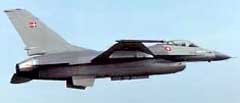2014-08-24 We want to thank our partner Risk Intelligence for bringing this video and posting to our attention.
Fighter Pilot Films First Person View Of Flight Over Fjords
GoPro-ing over Greenland.
Posted 08.21.2014
Being a fighter pilot is a lot of work.
Maintenance, years of training, planning for missions, paperwork — all just to pilot one of the faster, deadlier machines ever created by human hands.
Seems like a real hassle, right?
Fortunately for everyone who isn’t a fighter pilot, John Kristensen, a Danish Air Force pilot who flew missions in Afghanistan between 2002 and 2003, brought along his GoPro for a flight in an F-16 Fighting Falcon over Greenland.
The resulting video is stunning, as he races past icebergs, glaciers, ice floes, snow-covered plains, and fjords.
There’s a lot that’s frozen on the Greenland ice sheet, it turns out.
He also flies in formation with other pilots from Fighter Wing Skrydstrup.
Earlier, we looked at the role of F-16s within the defense of Greenland.
After a visit to Denmark, we published a piece on the challenge of defending Greenland.
But more broadly, there is the defense challenge, which is a Danish, NATO, and a US challenge.
Greenlanders live in the more temperate coastal areas; the rest of its two million sq km are covered in ice.
The US has had a presence in Greenland and took primary responsibility for the defense of Greenland throughout the Cold War. Yet the uncertainties of US policy, more generally and in the Arctic, as well as the dynamics of the Danish-Greenland relationship create an open-ended problem of how the security and defense of Greenland will be conducted in the period of the Arctic opening.
In an excellent overview to the challenge for the development and defense of Greenland, Mikkel Vedby Rasmussen, the head of the Centre for Military Studies, provided a way to conceptualize the problem.
The problem really is about the development of Greenland, the role of the local government in that development, the relationship between Denmark and Greenland in combining greater autonomy for Greenland while providing for defense and security and what role the US will have in the overall process.

In other words, the challenge will be to sort out in PRACTICAL terms how Greenland will be defended in the presence of greater outside powers influence through the mining companies, the dynamics of change between Denmark and Greenland, and the uncertainty about US policies and capabilities for Greenland defense and Arctic operations.
As part of the evolving defense effort, Greenland has worked with the Danish Air Force in leveraging Danish F-16s.
According to a recent press release from the Greenland government dated 8/5/14:
In connection with the Defense future tasks in the Arctic g F-16s will be flying on the west coast this week. The flight is part of the activities in connection with the ongoing analysis concerning the strengthening of the Danish Defense’s role in the Arctic.
An analysis has been initiated by the Danish Government and Greenland.
The overall purpose of the flight is to test F-16s as a sensor platform during a search and rescue operation (SAR) in Greenland, whereby the aircraft can quickly create a surveillance picture in the operation area, and forward this to the Arctic Command in Nuuk.
The flight has two underlying goals, to practice surveillance and image building on the West Coast as part of a SAR operation, and to test the logistical aspects of Kangerlussuaq and Thule. The flight will take place from Tuesday – Thursday with a day as buffer.
The flight is part of a series of trials and tests during 2014 and 2015 will be implemented as part of the large Arctic analysis, which includes a number of upcoming activities at sea and on land in and around Greenland.
For our look at the Arctic, fighters and what might constitute an “Arctic-enabled” fighter see the following:


